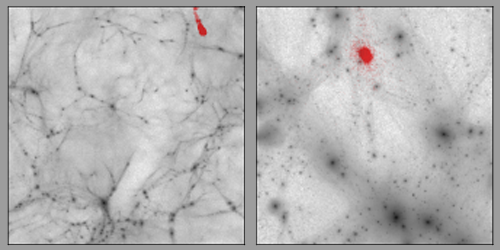Axion Miniclusters Might Be Microlenses
The axion, a leading dark matter candidate, is hypothesized to make up the dark matter halos thought to surround galaxies. In certain models, axions coalesce into “miniclusters”—dark matter clumps with masses of around 1019 kg. David Ellis at the Georg August University of Göttingen, Germany, and his colleagues now show that these miniclusters can act as gravitational lenses that magnify light from background sources [1]. They find a range of axion-particle masses for which the miniclusters might be observable in gravitational-lensing surveys.
The axion model predicts that axions formed in the early Universe. When the Universe cools below a certain temperature, topological defects form in the vacuum of space. If those defects originated during the radiation-dominated phase of the early Universe, their subsequent decay could have led to large, excess-density patches called minicluster seeds. These seeds would then have collapsed under gravity and merged to form axion miniclusters, possibly with Bose-Einstein condensates of axions—called axion stars—at their centers. But the properties of these miniclusters, such as their mass and density profile, remain uncertain and difficult to predict.
Using cosmological simulations, Ellis and his colleagues followed the evolution of the densest minicluster seeds over the Universe’s history. They found that the late-time minicluster density distribution fits the profile predicted for the hypothesized dark matter halos. They also found that if the axion mass is between 0.2 and 3 meV—a range supported by studies that predict the axion-particle mass using astronomical observations—enough of these miniclusters may be sufficiently dense to give rise to detectable gravitational-microlensing events. Models show that such microlensing should be hindered by the presence of axion stars, so to increase the confidence of their prediction, the researchers say that higher-resolution simulations are needed to determine the inner structure of the densest miniclusters.
–Rachel Berkowitz
Rachel Berkowitz is a Corresponding Editor for Physics Magazine based in Vancouver, Canada.
References
- D. Ellis et al., “Structure of axion miniclusters,” Phys. Rev. D 106, 103514 (2022).




